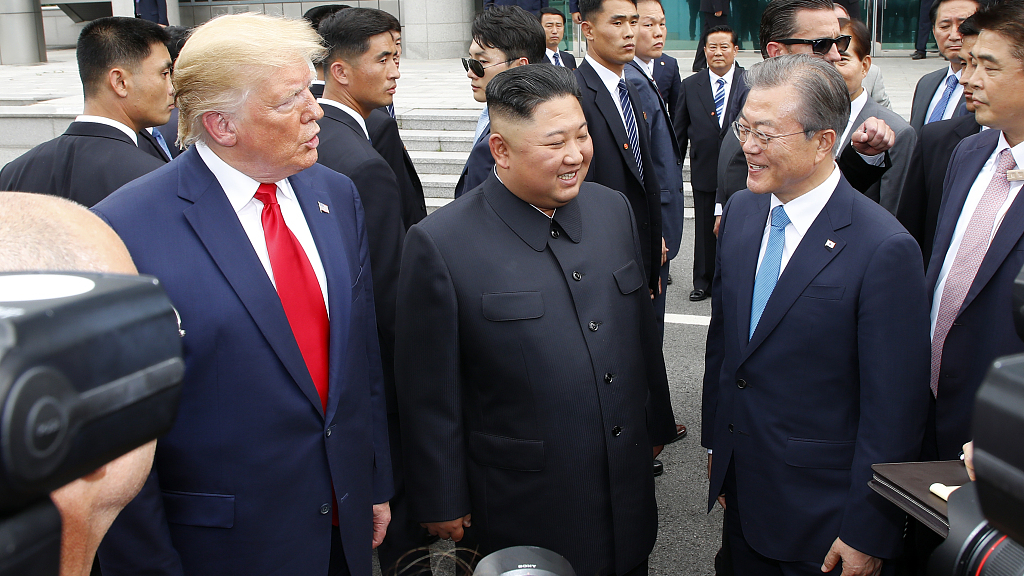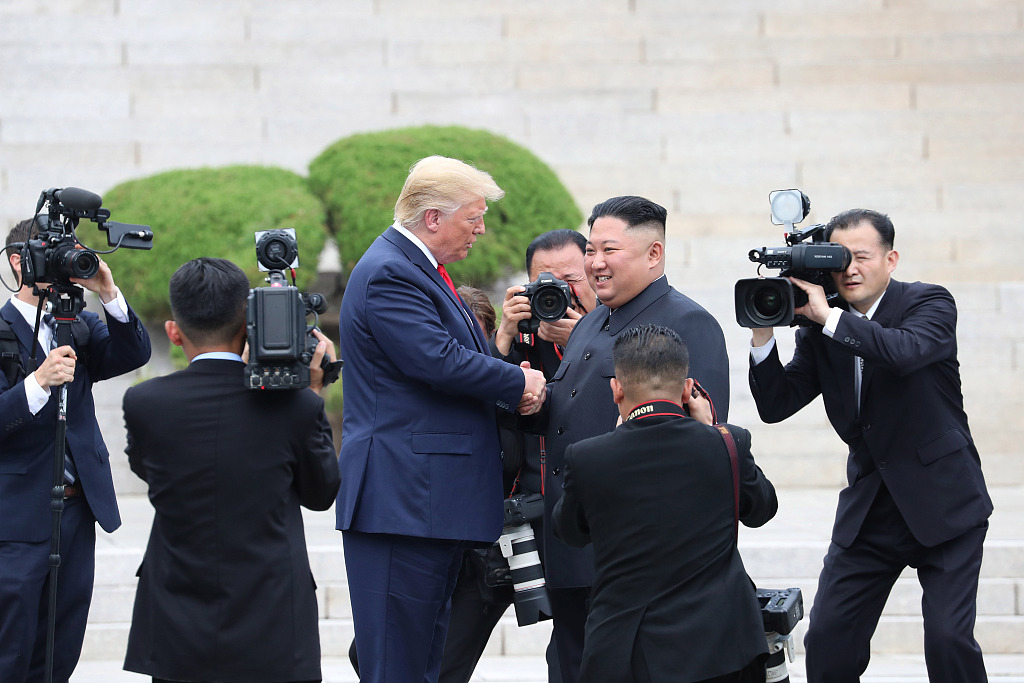

Editor's note: Chris Deacon is a postgraduate researcher in politics and international relations at the University of London and previously worked as an international commercial lawyer. The article reflects the author's opinion, and not necessarily the views of CGTN.
International news cameras were fixed to the scene of the Korean Demilitarized Zone (DMZ) on Sunday, as Donald Trump became the first sitting president of the United States to cross into the Democratic Republic of Korea (DPRK).
The dramatic crossing at the Panmunjom truce village preceded Trump and DPRK leader Kim Jong Un crossing back into the Republic of Korea (ROK) side, before both men created an also unprecedented three-way gathering between themselves and ROK President Moon Jae-in.
These dramatic and historic scenes were always guaranteed to steal the show. Trump is known to enjoy set-piece "made for television" scenes such as these – he regularly comments on the ratings achieved for his televised speeches and other occasions, and no doubt had the drama factor in mind when planning for this meeting.
That planning, however, seems to have been last-minute to say the least. The Trump-Kim meeting appeared to not even be confirmed in the days leading up to it, as the U.S. President dropped hints at the G20 summit occurring in Osaka, Japan that – when he stopped briefly in the ROK before his return trip – he might meet Kim at the border.

U.S. President Donald Trump walks with DPRK leader Kim Jong Un and ROK President Moon Jae-in at the Korean Demilitarized Zone, June 30, 2019. /VCG Photo
Trump no doubt had witnessed Moon Jae-in's own border crossing at Panmunjom and wanted to create some of the media-friendly magic for himself. In this way, many assumed that the Trump-Kim DMZ meeting would not form much more than a publicity stunt, with most analysts understanding that the encounter would only be a symbolic but brief contact between the two men.
In fact, they spoke for over an hour after the initial stage-managed choreography for the cameras. They agreed that the U.S. and DPRK would resume talks regarding the latter's nuclear weapons program, which have stalled in recent months after initial optimism following the two leaders' first meeting in Singapore last summer.
Their second meeting in Hanoi in February this year, however, was a disappointment, with the U.S. apparently walking out on talks and both sides blaming each other with mutual recriminations for the collapse in progress.
This Trump-Kim meeting, therefore, should be welcomed – but treated with cautious optimism at best. Anything which jump-starts the stalled nuclear talks is positive, but at some point concrete progress has to be made for us to believe that said talks are capable of bearing fruit.
This is a well-trodden path with the DPRK – for close to three decades now, talks have occurred, made progress, formed agreements, before said agreements collapse and the situation reverts back to square-one and, in fact, worsens.
Some – particularly the more hawkish members of the U.S. political establishment – might argue that continuing to tread this same path and expecting different results is illogical. However, the only sensible and tolerable solutions to the DPRK nuclear issue all stem from talking and diplomacy – war on the Korean Peninsula would simply be unconscionable.

U.S. President Donald Trump and DPRK leader Kim Jong Un briefly met at the Korean Demilitarized Zone (DMZ) on Sunday, June 30, 2019. /VCG Photo
Trump is right, therefore, to continue attempting diplomacy with the DPRK – even if we might disagree with his exact means and style. His particularly affectionate language regarding Kim Jong Un, for example, makes many Western observers deeply uncomfortable.
But, as things stand, it will be difficult to continue justifying the current set of talks without at least a hint of progress being made. Such progress is by no means impossible. Some analysts have suggested, for example, a phased approach in which the Yongbyon nuclear facility, and perhaps another, could be shut down in exchange for partial sanctions relief as an interim deal. In addition to achieving concrete results for both sides, such measures are likely to increase trust which could, in turn, result in further progress.
The glaringly obvious problem, however, is that currently such an agreement seems a long way off. Trump, therefore, takes part in Sunday's media-focused pageantry and rhetoric without anything concrete to back it up. This is neither sensible for the U.S. overall aims in the nuclear negotiations, nor a good look for U.S. foreign policy as a whole.
Of course, Trump, however, does things in his own way – as we all know by now. It would not be inconceivable for him to pull something out of the bag just when we least suspect it. For the time being, however, time is running out for the viability of this process unless something tangible can be achieved. Talking must always be encouraged – but that talking must produce results.
(If you want to contribute and have specific expertise, please contact us at opinions@cgtn.com)

Copyright © 2018 CGTN. Beijing ICP prepared NO.16065310-3
Copyright © 2018 CGTN. Beijing ICP prepared NO.16065310-3